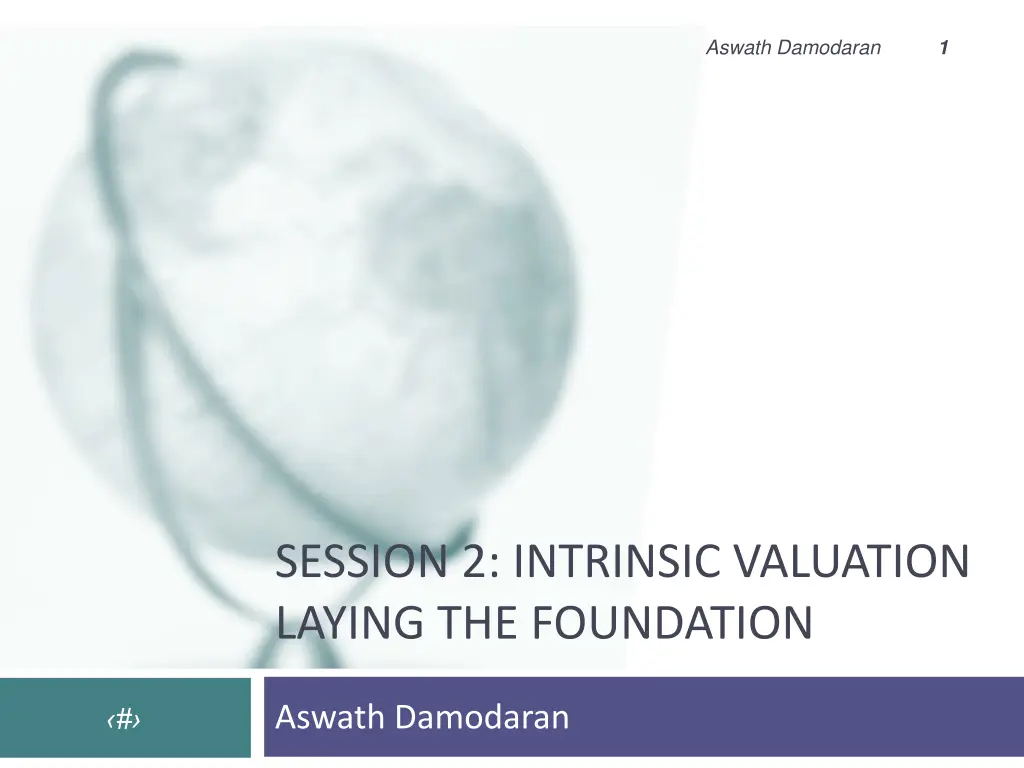
Intrinsic Valuation: Foundations and Principles
Discover the essence of intrinsic valuation as Aswath Damodaran lays the foundation for valuing assets based on cash flows, growth, and risk. Learn about discounted cash flow valuation and the key propositions for risk-adjusted value. Explore the choices between equity and firm valuation methods in this insightful session.
Download Presentation

Please find below an Image/Link to download the presentation.
The content on the website is provided AS IS for your information and personal use only. It may not be sold, licensed, or shared on other websites without obtaining consent from the author. If you encounter any issues during the download, it is possible that the publisher has removed the file from their server.
You are allowed to download the files provided on this website for personal or commercial use, subject to the condition that they are used lawfully. All files are the property of their respective owners.
The content on the website is provided AS IS for your information and personal use only. It may not be sold, licensed, or shared on other websites without obtaining consent from the author.
E N D
Presentation Transcript
Aswath Damodaran 1 SESSION 2: INTRINSIC VALUATION LAYING THE FOUNDATION Aswath Damodaran #
The Building Blocks for Value 2 Aswath Damodaran 2
The essence of intrinsic value 3 In intrinsic valuation, you value an asset based upon its fundamentals. Those fundamentals are cash flows, growth and risk. Discounted cash flow valuation is a tool for estimating intrinsic value. Aswath Damodaran 3
The two faces of discounted cash flow valuation 4 Discount expected cash flows at a risk adjusted discount rate: Discount certainty equivalent cash flows at a risk free rate. Aswath Damodaran 4
Risk Adjusted Value: Two Basic Propositions 5 Proposition 1: If your asset is never expected to generate positive cash flows, it cannot have positive value. Proposition 2: Assets that generate cash flows early in their life will be worth more than assets that generate cash flows later. Proposition 3: Assets with negative cash flows up front can still be worth a lot if they have disproportionately large positive cash flows later. Aswath Damodaran 5
DCF Choices: Equity Valuation versus Firm Valuation 6 Firm Valuation: Value the entire business Assets Liabilities Existing Investments Generate cashflows today Includes long lived (fixed) and short-lived(working capital) assets Fixed Claim on cash flows Little or No role in management Fixed Maturity Tax Deductible Assets in Place Debt Expected Value that will be created by future investments Growth Assets Equity Residual Claim on cash flows Significant Role in management Perpetual Lives Equity valuation: Value just the equity claim in the business Aswath Damodaran 6
Equity Valuation 7 Figure 5.5: Equity Valuation Assets Liabilities Assets in Place Debt Cash flows considered are cashflows from assets, after debt payments and after making reinvestments needed for future growth Discount rate reflects only the cost of raising equity financing Growth Assets Equity Present value is value of just the equity claims on the firm Aswath Damodaran 7
Firm Valuation 8 Figure 5.6: Firm Valuation Assets Liabilities Assets in Place Debt Cash flows considered are cashflows from assets, prior to any debt payments but after firm has reinvested to create growth assets Discount rate reflects the cost of raising both debt and equity financing, in proportion to their use Growth Assets Equity Present value is value of the entire firm, and reflects the value of all claims on the firm. Aswath Damodaran 8
Generic DCF Valuation Model 9 Aswath Damodaran 9
First Principle of Valuation 10 Consistency principle: Your discount rate should match up to your cash flows. The key error to avoid is mismatching cashflows and discount rates: Discounting cash flows to equity at the weighted average cost of capital will lead to an upwardly biased estimate of the value of equity Discounting cash flows to the firm at the cost of equity will yield a downward biased estimate of the value of the firm. Aswath Damodaran 10
